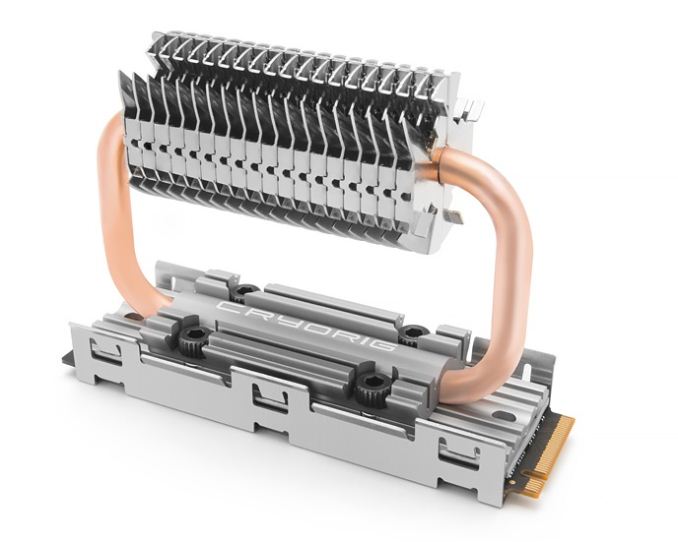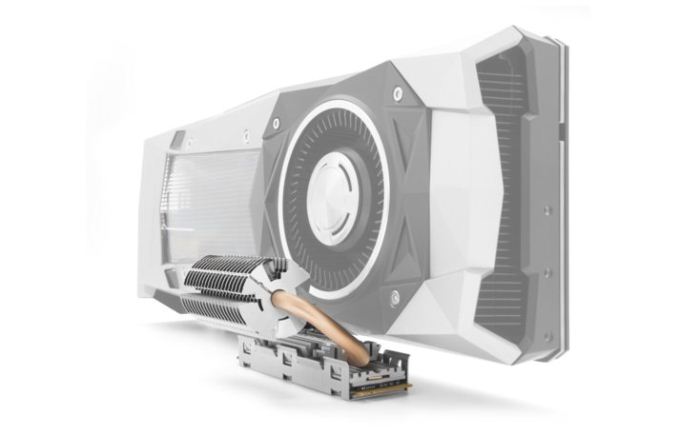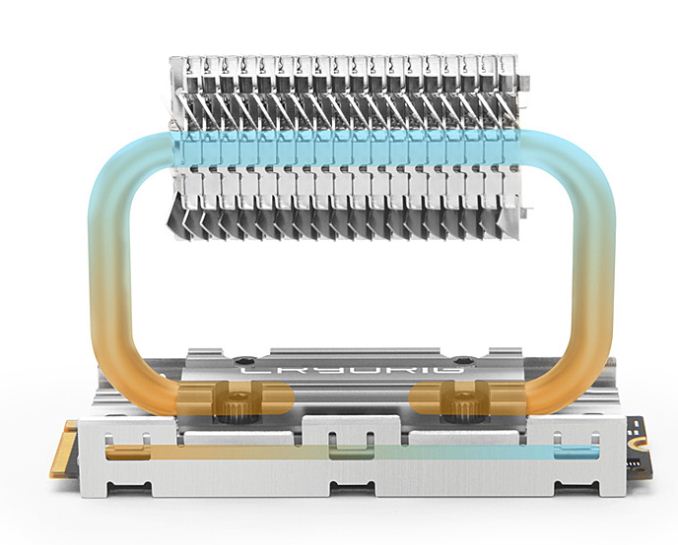Cryorig Set to Reveal the Dual Heatpipe Frostbit M.2 SSD Cooler
by Gavin Bonshor on May 24, 2018 4:00 PM EST
With the ever-raging debate about the correlation of high thermals and the performance throttling of M.2 SSDs being a hot topic, Cryorig intends to unveil an interesting and aggressive styled M.2 SSD based cooling solution at Computex 2018: the Frostbit M.2 SSD Cooler.
The Cryorig Frostbit M.2 SSD Cooler is the first mass-manufactured M.2 cooler to feature a dual stacked heatpipe design and carries a weight of 56 g and a maximum thermal dissipation rating of 12 W. 12W is well past what any conventional SSD is capable of outputting, so with good contact this cooler will certainly be overkill. Those worried about obstruction from large GPUs especially the ones directly slotted above the M.2 slot, the larger copper heatpipe on the Frostbit allows for adjustment (as displayed in the below graphic). The second and smaller heatpipe is integrated into the base of the cooler meaning the larger 6 mm heatpipes job is to relocate and direct the heat into the passive cooled 38 fin arrayed cylindrical end.
To function effectively, some degree of passive airflow will be required to ensure optimal operation, especially during long and arduous tasks such as large data transfers.
The actual size of the heatsink measures at a svelte 72 x 27.3 x 57 mm (L x W x D) which only presents a problem to M.2 SSDs with a length of 110 mm and beyond. This is due to the core design as the Frostbit is designed to only cover the components on the M.2 SSDs PCB as to not interfere with the mounting screw or the interface featured at either end of a 2280 drive.
The specific details regarding the availability and pricing of the Cryorig Frostbit are currently unknown, although more details are expected to be announced at the upcoming Computex 2018 show in Taipei Taiwan which runs from 5th June - 9th June 2018.
Related Reading
Source: Cryorig

















15 Comments
View All Comments
Dragonstongue - Thursday, May 24, 2018 - link
motherboard makers take note...this is a PROPER "heatshield" like design, yes it is larger but at least it likely actually HELPS temperatures rather than just being fud to "upsell" your design choice...something like this would work quite nice if they moved the m.2/u.2 sockets to a place not impeded by much of anything in today's modern cases that pretty much get rid of excess cables and such.place right behind the spot normally taken up by the sata connectors every mobo I have seen this is a very empty spot rather than trying to cram it under gpu/soundcard/cpu sockets, amd sure if they did a decent job with a style of interposer than can pretty much put the "slot" wherever they want, at least this way here the gpu-cpu etc is not at all impeded by something else preventing full population of pci-e usable space.
seems like a slick design, I think they probably could have done a full "flower" type effect so the fins are as wide open as possible instead of having looks like ~1/3 to 1/4 of the fins being "bent over" the heatpipe, they could have used solder or whatever likely would have increased ambient ability to release the heat (passive) instead of needing potential more "semi-active" either way probably is WAY better than every motherboard that uses a heatsheild that promises but never delivers this and for a "bare" m.2/u/2 likely will help quite a bit just the same.
likely it will not be "bargain friendly" guessing $20-$40 USD per...
dromoxen - Thursday, May 24, 2018 - link
Surely this needs a small pump and reservoir , maybe a fan too?MadAd - Thursday, May 24, 2018 - link
Two fans, push pull.EnzoFX - Tuesday, May 29, 2018 - link
Don't forget RGB.nevcairiel - Thursday, May 24, 2018 - link
I can see the reason for the placement being PCIe routing.edzieba - Friday, May 25, 2018 - link
A 'proper' heatsink, but a product that has as much reason to exist as RAMsinks*: none at all. It is a very shiny heatsink, but merely cosmetic in function.*except for DDR2 FBDIMMS, that never made their way to consumer machines. Likewise, the only NVME m.2 SSD that had any need for a heatsink was the PM871, because it was intended for OEMs to reflash the firmware with the correct throttling values (and to be thermally linked to the chassis oft he machine it was to be integrated with), which consumers buying the OEM drive did not do.
darckhart - Thursday, May 24, 2018 - link
hilarious. U.2 ftwDeath666Angel - Friday, May 25, 2018 - link
Totally different use case.darckhart - Monday, May 28, 2018 - link
only if size is your constraint... which with this, clearly it isn't.Death666Angel - Wednesday, May 30, 2018 - link
Aesthetics might be another one. And it is one thing to have a constrution like this on a motherboard that is lower than the height of the CPU cooler and graphics card and within the size of the motherboard dimensions. But it is another to have a U.2 2.5" SSD around that you have to put somewhere by screwing or glueing it in place. I can think of many cases where I would have no trouble using this M.2+heatsink combination, but where U.2+2.5" would give me a slight headache. Especially since this is mostly cosmetic since throttling usually just happens after 100s of GBs of tranfers.